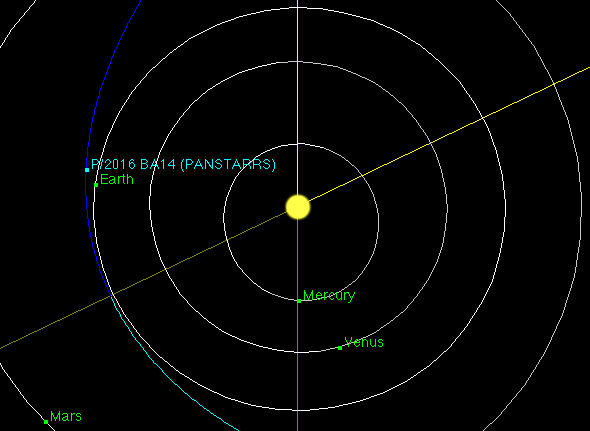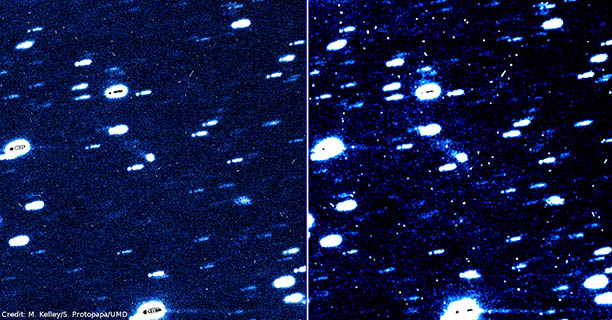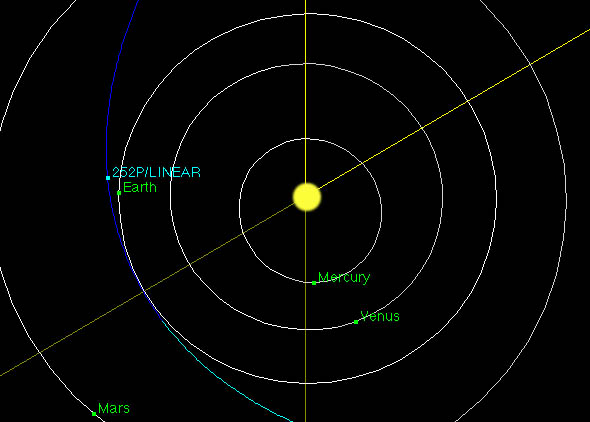Click https://www.youtube.com/watch?v=FP-m9L-sv8A&feature=player_detailpage for 2-hour interview of Alex Collier from the Open Your Mind Radio internet network.
One interesting aspect: Collier calls for the orbit of Planet X to move through the orbit of Planet Earth in mid-to-late March of 2016, and we are currently having two comets pass by us (and within Collier's claimed time-frame) as I write this in late March 2016.
Comet P/2016 BA14’s Historic Flyby of Earth
Not one, but two, possibly related comets will make exceptionally close flybys of Earth on March 21–22. Here's what we know and a guide on how to see them.

Comet P/2016 BA14 (Pan-STARRS) will make a safe but extremely close pass of Earth on March 22nd.
NASA / JPL
You'd have to go back to 246 years to find a comet that passed closer to Earth than Comet PanSTARRS (P/2016 BA14) will on March 22nd. Predicted to come within about nine lunar distances (2.1 million miles or 3.4 million kilometers) of Earth around 16:00 UT on that day, P/2016 BA14 will soon claim the distinction of third closest comet ever recorded.
Lexell's Comet has them all beat. It missed Earth by 1.4 million miles (2.2 million kilometers) on July 1, 1770. Although discovered in June that year by the comet ferret himself, Charles Messier, it became popularly known as Lexell's Comet after astronomer and mathematician Anders Johan Lexell computed its orbit. As the comet sprinted across the sky in late June and early July, Messier described the coma as more than four times the size of the full Moon and as bright as magnitude +2. Wow!
We'll see plenty of action from P/2016 BA14 as it speeds from Canis Major to Ursa Major in the span of just 7 nights, but you'll need a telescope to spot it. When first discovered on January 21st of this year by the PanSTARRS 1 telescope, it was given an asteroid designation, 2016 BA14. Soon after, Russian astronomer Denis Denisenko noticed that it's orbit was remarkably similar to comet 252P/LINEAR, discovered in 2000 and on course for a similar close approach to Earth this month.

Images by Michael S. P. Kelley and Silvia Protopapa (UMD) confirming Matthew Knight's initial discovery of a cometary tail behind "asteroid" 2016 BA14. The comet is at the center of both frames.
M. Kelley / S. Protopapa / University of Maryland
Could they be related? Astronomers Michael Kelley and Matthew Knight wanted to find out, so they observed 2016 BA14 with Lowell Observatory's Discovery Channel Telescope in February. Sure enough, their photos revealed a tail. Two comets on nearly identical orbits with nearly the same period of 5.32 (252P) and 5.25 years (BA14) imply a common origin. The most likely scenario? A chunk of 252P/LINEAR spalled off to become P/2016 BA14. The "P" designation stands for periodic and indicates that both comets make repeat orbits around the sun.
- See more at: http://www.skyandtelescope.com/observing/p2016-ba14-closest-comet-in-almost-250-years03162016/#sthash.nAGC9GaG.dpuf
You need to be a member of Ashtar Command - Spiritual Community to add comments!








Replies